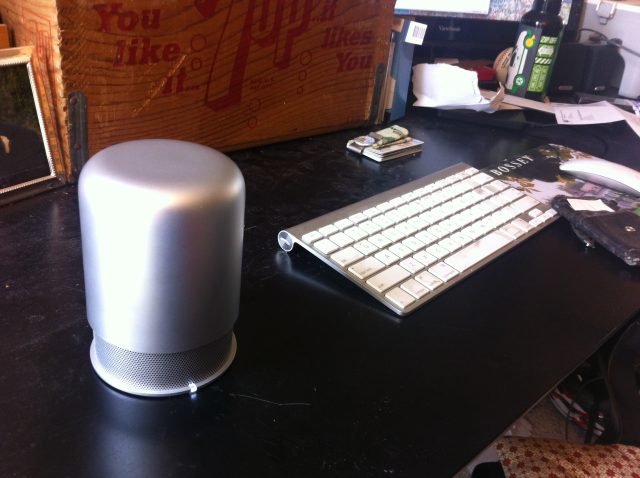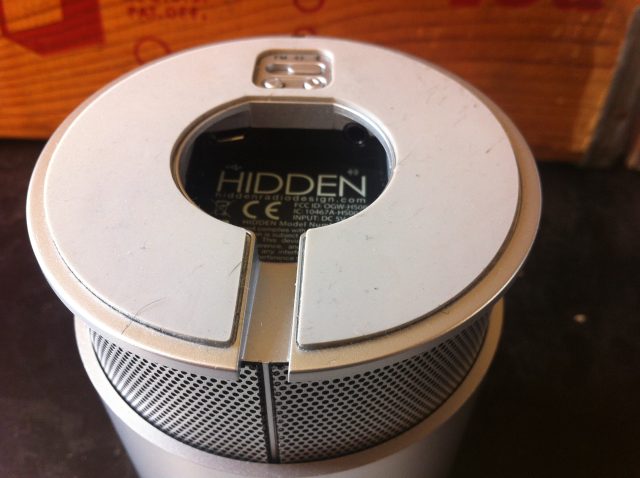
UPDATE October 25, 2012: After reading my review, Jon Van Den Nieuwenhuizen and Vitor Santa Maria met with me, in-person, in an Oakland café. They tested my speaker and concluded that it was one of the few that had manufacturing defects and offered to replace it. Indeed, the new one that they brought twisted much more easily and I've been happily using it ever since.
When I first heard about the Hidden Radio speaker, I was in love—it had a gorgeous design, an intuitive interface, and to top it all off, I was in the market for a speaker anyway.
My wife and I often watch The Daily Show on her laptop in the evenings (we don’t own a TV). But the MacBook Air’s speaker just isn’t very powerful. In fact, if there are noises coming from outside, catching all of Jon Stewart’s jokes can be difficult to hear, even at full volume. So when I saw that there was this new speaker that could "fill an apartment" with sound—as it says in the promo video—I was definitely hooked. I immediately dropped in $120 for their Kickstarter campaign in December 2011 and waited for the Bluetooth speaker to arrive. (That campaign, which originally asked for a total of $125,000, eventually reached over $900,000.)
My Hidden Radio finally did arrive, earlier this month. After using it for a few days, I have to say it’s an impressive device, but it does have its flaws. It easily serves its purpose (as a small, bedroom speaker)—but I wouldn’t use it to replace my larger living room (2.1) or office (4.1) speaker setup.
The good news is, the Hidden Radio works great for what we wanted it to do—be a compact speaker. It fits nicely on my wife’s nightstand, without taking up much space—it’s roughly the size of a takeout cup of coffee. It makes our evening online TV watching much more enjoyable. The bad news is, its main design feature (one-handed volume adjustment) doesn’t work quite as well as advertised.

Do the twist!
The Hidden Radio comes with two sleek, Apple-style brushed metal cylinders that sit concentrically inside one another. Adjusting the volume is a simple matter of twisting the cap (the outer cylinder), exposing the speaker panel below. Twist up to increase the volume, and twist down to lower it. When the speaker is all the way closed, it’s off. (Smart!)
It has no visible buttons—just a small LED light that tells you if it’s on, and/or connected. Flip it over, and it has a small three-notched button for Bluetooth, line-in, and an FM radio (along with two small seek buttons). There are also tiny, recessed jacks for mini-USB (to charge it) and a line-in. I appreciate devices whose designers put some thought into how they’ll fit in with the rest of my gadgets. It almost exactly matches my brushed metal Apple keyboard, not to mention the MacBook Air.
From my experience, using the speaker primarily for spoken word items (TV shows, movies, podcasts) worked very well. The sound was definitely much fuller (not to mention louder) than when it plays out of the built-in Apple speakers. It can easily fill our bedroom, not to mention our apartment if we really crank it. (Our neighbors probably wouldn’t be too happy, though.)
My decibel readings agreed that the Hidden Radio speaker's sound is respectable. When cranked, it topped out around 95 dB (above what’s advertised). The treble and mid-range sounded good, but the bass—as to be expected on a portable device—definitely left something to be desired.
"Grippy" silicone
While I like the device, I think that it’s worth mentioning that the twisting feature, particularly to increase volume simply does not work as well as the company claims. (I’m not the only reviewer to have said so.) The promo video shows a disembodied hand effortlessly twisting the cap to open up the speaker. Both my wife and I found—testing it on different hard surfaces—that the base grip didn’t always keep the speaker in place while trying to increase the volume.
Also, closing the speaker to reduce the volume was fine, but I found that at least one out of every three times I tried to adjust it, the whole speaker would simply rotate along the surface.
When I emailed John Van Den Nieuwnhuizen, one of Hidden’s designers and co-founders, about this, he suggested that I try “slightly pressing down the lid while turning.”
I found that I really had to press hard into the center of the cap to make sure that the speaker stood stationary. For a product that is supposed to be so intuitive that it comes with no instructions (another feature touted in the promo video), the fact that I have to be told how to adjust the volume is definitely an issue.
In another e-mail, Van Den Nieuwnhuizen said that the company had designed the base to be "grippy."
"We also chose a particular type of silicone to achieve this," he added. "The cause for it slipping could be that it has gotten dirty on the bottom, which can be easily cleaned with a damp cloth. As I said previously, pressing down on the cap slightly while turning generally alleviates this issue."
Cleaning the bottom certainly helped, but again, I don’t expect to have to clean my speaker on a regular basis.
The FM radio features also seems like something of an after-thought, given there’s no way to manually adjust the dial. You just have to trust that the auto-seek will eventually find something that you want to listen to, or that the station you do want will come in strong enough for you to hear it. (I’d love to see some sort of smartphone app that would let me manually control the radio tuner.)
The bottom line
So, would I recommend it? Yes, albeit with some caveats. Overall, this is a solid little device that will do nicely as a bedroom speaker. It’s certainly not going to replace anyone's desktop or living room sound system anytime soon.
I’d also tell people what the designer told me—that despite the company claiming it doesn’t need instructions, that you have to press down firmly on the speaker to adjust the volume, and failing that, try cleaning the bottom.
I was able to snag one for the price of $120, which seemed like a fair deal. The current price, though, is $150—the company says it’s raising that to $190 after November 15. At a 33 percent increase over what I paid, I’m not sure that I would buy another one, but then again, like many products, a lot of what you’re paying for is that slick, modern industrial design.
reader comments
69